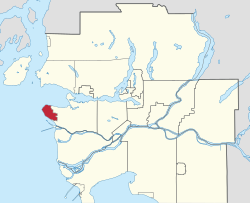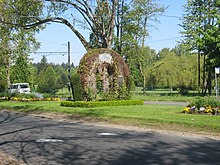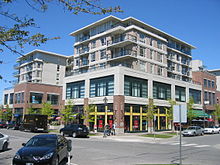
Richmond is a city in the coastal Lower Mainland region of British Columbia, Canada. It occupies almost the entirety of Lulu Island, between the two estuarine distributaries of the Fraser River. Encompassing the adjacent Sea Island and several other smaller islands and uninhabited islets to its north and south, it neighbours Vancouver and Burnaby on the Burrard Peninsula to the north, New Westminster and Annacis Island to the east, Delta to the south, and the Strait of Georgia to the west.

The University of British Columbia (UBC) is a public research university with campuses near Vancouver and in Kelowna. Established in 1908, it is the oldest university in British Columbia. With an annual research budget of $759 million, UBC funds over 8,000 projects a year.

Pacific Spirit Regional Park is a 874 hectares park located in the University Endowment Lands, on Point Grey to the west of the city of Vancouver, British Columbia. It surrounds the endowment lands of the University of British Columbia on the shores of Georgia Strait in the Pacific Ocean. It is a nature preserve of the British Columbia government and classified under Electoral Area A.
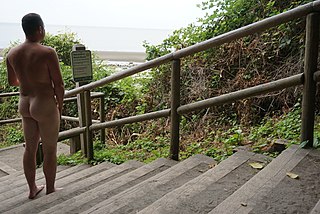
Wreck Beach is a clothing-optional beach located in Pacific Spirit Regional Park, which is in turn part of the University Endowment Lands just west of Vancouver, British Columbia, Canada. The clothing-optional section is clearly marked with signs and stretches approximately 6.7 kilometres or 4.2 miles from Acadia Beach, in the north, to the Booming Grounds Creek on the north arm of the Fraser River. The park is administered by the Greater Vancouver Regional District (GVRD), though Indigenous claims are repeatedly asserted, especially by the Musqueam Nation.

Kitsilano is a neighbourhood located in the city of Vancouver, British Columbia, Canada. Kitsilano is named after Squamish chief August Jack Khatsahlano, and the neighbourhood is located in Vancouver's West Side along the south shore of English Bay, between the neighbourhoods of West Point Grey and Fairview. The area is mostly residential with two main commercial areas, West 4th Avenue and West Broadway, known for their retail stores, restaurants and organic food markets.
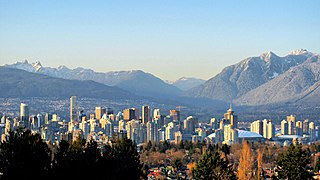
Greater Vancouver, also known as Metro Vancouver, is the metropolitan area with its major urban centre being the city of Vancouver, British Columbia, Canada. The term "Greater Vancouver" describes an area that is roughly coterminous with the region governed by the Metro Vancouver Regional District (MVRD), though it predates the 1966 creation of the regional district. It is often used to include areas beyond the boundaries of the regional district but does not generally include wilderness and agricultural areas that are included within the MVRD.

University Hill Secondary School is a public secondary school in the neighbourhood of Wesbrook Place in Point Grey Campus, just west of the University Endowment Lands and the city limits of Vancouver, British Columbia, Canada.

The Vancouver School Board (VSB), officially the Board of Education of School District No. 39 (Vancouver), is a school district based in Vancouver, British Columbia, Canada. A board of nine elected trustees governs this school district that serves the city of Vancouver and the University Endowment Lands.

The Musqueam Indian Band is a First Nations band government in the Canadian province of British Columbia. It is the only First Nations band whose reserve community lies within the boundaries of the City of Vancouver.

The history of Vancouver, British Columbia, is one that extends back thousands of years, with its first inhabitants arriving in the area following the Last Glacial Period. With its location on the western coast of Canada near the mouth of the Fraser River and on the waterways of the Strait of Georgia, Howe Sound, Burrard Inlet, and their tributaries, Vancouver has – for thousands of years – been a place of meeting, trade, and settlement.
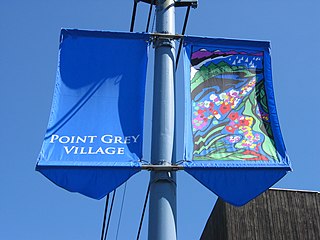
West Point Grey is a neighbourhood in the northwest of the city of Vancouver, British Columbia, Canada. It is on Point Grey and bordered by 16th Avenue to the south, Alma Street to the east, English Bay to the north, and Blanca Street to the west. Notable beaches within West Point Grey include Spanish Banks, Locarno and Jericho. Immediately to the south is Pacific Spirit Regional Park and to the east is Kitsilano.

Vancouver Hospital and Health Sciences Centre (VHHSC) is an acute care hospital affiliated with the University of British Columbia and located in Vancouver, British Columbia. The VHHSC is the second largest hospital in Canada, with 1,900 beds and nearly 116,000 patients each year. VHHSC employs 9500 staff and utilizes 1000 volunteers. As of 2005, the hospital's annual budget is $463 million. It is managed by Vancouver Coastal Health.

Dunbar–Southlands is a neighbourhood on the western side of Vancouver, British Columbia, Canada, that stretches north from the Fraser River and covers most of the land between the mouth of the Fraser and English Bay.
The UBC's Okanagan Campus is one of the University of British Columbia's campus located in Kelowna, British Columbia, Canada.

The University Golf Club is a public golf club located in Pacific Spirit Regional Park near the city of Vancouver, British Columbia, Canada and the University of British Columbia. It is owned and operated by Musqueam Capital Corporation.
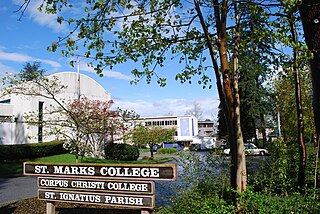
Corpus Christi College (CCC) is a college affiliated with and situated on the campus of University of British Columbia (UBC). The college offers classes in arts, business, and science in small class sizes with close student-faculty interaction.

The University of British Columbia's (UBC) Point Grey Campus is the main campus of the university. It is located on the Point Grey peninsula in British Columbia, Canada. It is home to close to 55,000 undergraduate and graduate students. The 402-hectare (993-acre) campus is also home to a numerous residential housing developments that were built by UBC in conjunction with private developers.
Marine Drive is the name for three major roadways in Greater Vancouver, British Columbia, Canada. The roads are known for running parallel to major bodies of water, with some sections being a major arterial road, while other serve local traffic. Marine Way is the name applied to a section of Marine Drive that was bypassed in the early 1980s.
